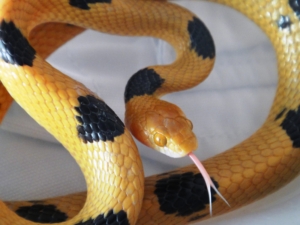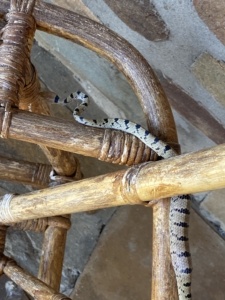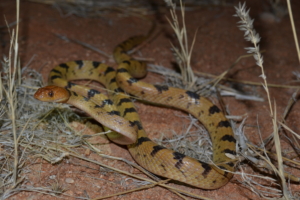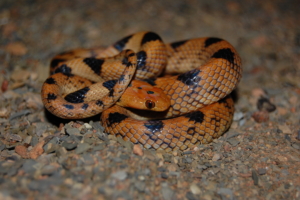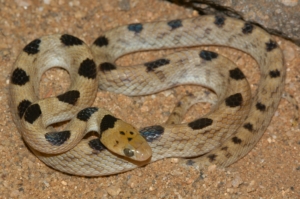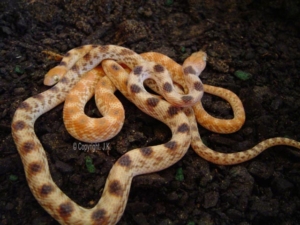Tiger Snakes of Southern Africa
The Tiger Snakes of Southern Africa, from the genus Telescopus, form part of a fascinating group of rear-fanged snakes commonly known as tiger snakes or cat snakes. Tiger Snakes are found across diverse habitats in Africa and parts of the Middle East and Southeast Europe, on the coast of the Adriatic Sea. These primarily nocturnal reptiles exhibit slender bodies with distinct heads, characteristic patterns of blotches or bands, and prominent eyes with vertical pupils, reflecting their crepuscular and nocturnal lifestyles. While possessing mild venom delivered through rear fangs, they are generally not considered a significant threat to humans and play intriguing roles within their respective ecosystems, primarily as predators of lizards and other small vertebrates.
Eastern or Common Tiger Snake
Telescopus semiannulatus
Description:
The common tiger snake is a slender, medium-sized snake characterized by a pale orange to salmon pink base color adorned with 24 to 48 distinct black or dark-brown crossbars or blotches along its back and tail. Its underside is typically paler, ranging from pale yellow to orangish pink on the throat, fading towards the tail. It possesses prominent orange eyes with vertical pupils and a head clearly distinct from its body.
Distribution:
This species has a wide distribution across central, eastern, and southern Africa, including countries like Angola, Democratic Republic of the Congo, Kenya, South Africa, and Zimbabwe.
Habitat:
It is an adaptable snake found in various subtropical and tropical habitats, including rocky deserts, scrublands, savannas, and lowland forests. It is both terrestrial and arboreal, often seeking shelter under bark, in rock crevices, and even in human dwellings.
Diet:
The primary diet consists of lizards, particularly geckos. However, it is an opportunistic feeder and will also consume small rodents, fledgling birds, and occasionally bats.
Western Tiger Snake
Telescopus polystictus
Description:
The Western tiger snake was previously considered a subspecies of Telescopus semiannulatus but exhibits distinct characteristics. It tends to have a more mottled appearance rather than clear crossbands and possesses a significantly higher number of dark markings, often exceeding 75 along its body. Its coloration is typically a lighter brown or greyish base with darker blotches.
Distribution:
This form is primarily found in the highveld regions of Namibia and the extreme northwest of South Africa in parts of the Richtersveld.
Habitat:
It inhabits arid and semi-arid environments, including rocky outcrops, dry savannas, and sparsely vegetated areas within its distribution range. It often seeks shelter amongst rocks and within crevices.
Diet:
Similar to Telescopus semiannulatus, the diet of Telescopus polystictus mainly comprises lizards. Small rodents and other small vertebrates may also be consumed opportunistically.
Beetz's or Karoo Tiger Snake
Telescopus beetzii
Description:
Beetz’s tiger snake is a relatively small species within the Telescopus genus. It typically displays a pale grey to light brown base color with irregular darker blotches or bands along its body. The pattern can be somewhat variable, and the markings may appear faded or indistinct in some individuals. Its ventral side is usually lighter, often a creamy white.
Distribution:
This species has a more restricted distribution, primarily found in arid regions of southwestern Namibia, Namaqualand and Northern Cape
Habitat:
Telescopus beetzi is adapted to arid and semi-desert habitats characterized by rocky terrain and sparse vegetation. It is likely nocturnal and seeks refuge in rock crevices and under stones during the day to avoid the harsh conditions.
Diet:
The diet is believed to consist mainly of small lizards found within its arid habitat. Further specific details on its diet may require more focused research.
Finkeldey's Tiger Snake
Telescopus finkeldeyi
Description:
Finkeldey’s tiger snake is another lesser-known species. It is characterized by a pale yellowish-brown to tan base color with a series of darker brown or blackish blotches or saddles along its back. These markings can vary in shape and definition. The underside is typically a uniform pale color.
Distribution:
This species is currently known from a limited area in central Namibia. Its distribution range appears to be relatively restricted compared to some other Telescopus species.
Habitat:
It inhabits arid to semi-arid rocky environments. Information on its specific habitat preferences is still developing, but it is likely a nocturnal, terrestrial species that shelters amongst rocks and in crevices.
Diet:
The diet is presumed to consist primarily of small lizards that are common in its arid environment. Like Telescopus beetzi, more specific dietary information may require further research.






